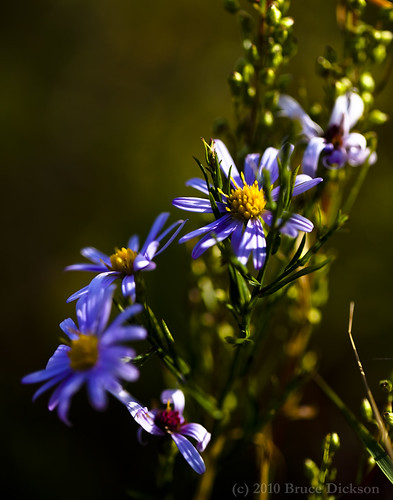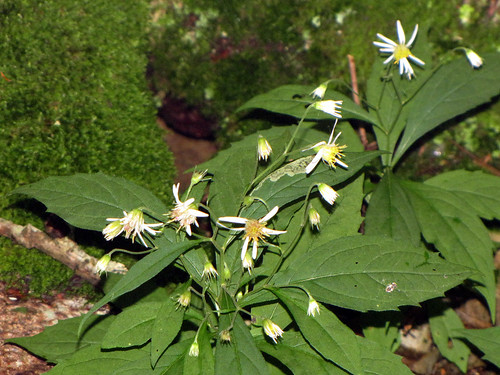Daisy Flower!!!
Image by Natesh Ramasamy
Asteraceae or Compositae (commonly referred to as the aster, daisy, or sunflower family), are an exceedingly large and widespread family of vascular plants. The group has more than 22,750 currently accepted species, spread across 1620 genera and 12 subfamilies. In terms of numbers of species, Asteraceae is rivaled only by Orchidaceae. (Which of the two families is actually larger is unclear, owing to uncertainty about exactly how many species exist in each family). The largest composite genera are Senecio (1,000 species), Vernonia (1,000 species), Centaurea (700 species), Cousinia (600 species), Helichrysum (550 species), and Artemesia (550 species).
Courtesy : en.wikipedia.org/wiki/Asteraceae
Lanceleaf Tickseed, Coreopsis lanceolata ....#3
Image by Vietnam Plants & America plants
Taken on April 15, 2012 in Waco city, Texas state, Southern of America.
Vietnamese named :
Common names : Lanceleaf Tickseed
Scientist name : Coreopsis lanceolata L
Synonyms :
Family : Asteraceae/ Aster family . Họ Cúc
Kingdom : Plantae – Plants
Subkingdom: Tracheobionta – Vascular plants
Superdivision : Spermatophyta – Seed plants
Division: Magnoliophyta – Flowering plants
Class : Magnoliopsida – Dicotyledons
Subclass : Asteridae
Order : Asterales
Genus : Coreopsis L. – tickseed
Species: Coreopsis lanceolata L. – lanceleaf tickseed
**** plants.usda.gov/java/profile?symbol=cola5
**** www.flickr.com/photos/ericinsf/6954492702/in/photostream/
**** www.wildflower.org/plants/result.php?id_plant=COLA5
FLOWER PICTURE
**** www.wildflower.org/gallery/result.php?id_image=13823
LEAVES PICTURE
**** www.efloras.org/florataxon.aspx?flora_id=1&taxon_id=2...
19. Coreopsis lanceolata Linnaeus, Sp. Pl. 2: 908. 1753.
Perennials, 10–30(–60+) cm. Aerial nodes proximal to first peduncle usually 1–3(–5+), distalmost 1–3 internodes 1–2(–8+) cm. Leaves: basal and cauline on proximal 1/4–1/3(–1/2) of plant heights; petioles 1–5(–8+) cm; blades simple or with 1–2+ lateral lobes, simple blades or terminal lobes lance-ovate or lanceolate to oblanceolate or lance-linear, 5–12 cm × 8–15(–18+) mm. Peduncles (8–)12–20(–35+) cm. Calyculi of lance-ovate to lance-linear or linear bractlets 4–8(–12) mm. Phyllaries deltate to lance-deltate, 8–12+ mm. Ray laminae yellow, 15–30+ mm. Disc corollas 6–7.5 mm, apices yellow. Cypselae (2.6–)3–4 mm, wings ± spreading, ± chartaceous, entire. 2n = 26 (+ 0–4B).
Flowering (Mar–)May–Jul(–Aug). Sandy soils, ditches and roadsides, other disturbed sites; 30–500(–1000+) m; B.C., Ont.; Ala., Ark., Fla., Ga., Ill., Ind., Kans., Ky., La., Md., Mich., Miss., Mo., N.J., N.Mex., N.Y., N.C., Ohio, Okla., Pa., S.C., Tenn., Tex., Vt., Va., W.Va., Wis.
Plants that have been called Coreopsis lanceolata var. villosa Michaux often have 5+ aerial internodes 6+ cm long proximal to the first peduncle; they may merit recognition as a distinct taxon or may be hybrids (or derivatives) from crosses between C. lanceolata and C. pubescens.
****
**** en.wikipedia.org/wiki/Coreopsis_lanceolata
**** edis.ifas.ufl.edu/ep058
**** www.weeds.org.au/cgi-bin/weedident.cgi?tpl=plant.tpl&...
Origin: Native to central and south-east United States of America
Weed Type(s): Weed, Naturalised, Native Weed, Garden Escape, Environmental Weed, Cultivation Escape
Notes: Coreopsis is a large genus of about 80 species of annual or perennial herbs. Sometimes called Tickseed in reference to the appearance of the seeds which are wind-dispersed. Coreopsis lanceolata is an erect annual or short-lived perennial forming a clump of dark green, deeply-lobed leaves up to 1m tall. Flowers are yellow on long leafless stalks.
It is a weed of agricultural and wasteland in South Africa. In Western Australia it is a garden escape along the roadside between Perth and Albany and it is known in the Blue Mountains in NSW. In Queensland it was first recorded as naturalised in Kingaroy in 1944 and is currently spreading as a roadside weed from Tin Can Bay to the NSW border. It is also abundant in the Stanthorpe district and has the potential to become a major ground cover weed in forested areas in coastal and sub-coastal districts of Queensland and NSW.
Lanceleaf Tickseed, Coreopsis lanceolata ....#4
Image by Vietnam Plants & America plants
Taken on April 15, 2012 in Waco city, Texas state, Southern of America.
Vietnamese named :
Common names : Lanceleaf Tickseed
Scientist name : Coreopsis lanceolata L
Synonyms :
Family : Asteraceae/ Aster family . Họ Cúc
Kingdom : Plantae – Plants
Subkingdom: Tracheobionta – Vascular plants
Superdivision : Spermatophyta – Seed plants
Division: Magnoliophyta – Flowering plants
Class : Magnoliopsida – Dicotyledons
Subclass : Asteridae
Order : Asterales
Genus : Coreopsis L. – tickseed
Species: Coreopsis lanceolata L. – lanceleaf tickseed
**** plants.usda.gov/java/profile?symbol=cola5
**** www.flickr.com/photos/ericinsf/6954492702/in/photostream/
**** www.wildflower.org/plants/result.php?id_plant=COLA5
FLOWER PICTURE
**** www.wildflower.org/gallery/result.php?id_image=13823
LEAVES PICTURE
**** www.efloras.org/florataxon.aspx?flora_id=1&taxon_id=2...
19. Coreopsis lanceolata Linnaeus, Sp. Pl. 2: 908. 1753.
Perennials, 10–30(–60+) cm. Aerial nodes proximal to first peduncle usually 1–3(–5+), distalmost 1–3 internodes 1–2(–8+) cm. Leaves: basal and cauline on proximal 1/4–1/3(–1/2) of plant heights; petioles 1–5(–8+) cm; blades simple or with 1–2+ lateral lobes, simple blades or terminal lobes lance-ovate or lanceolate to oblanceolate or lance-linear, 5–12 cm × 8–15(–18+) mm. Peduncles (8–)12–20(–35+) cm. Calyculi of lance-ovate to lance-linear or linear bractlets 4–8(–12) mm. Phyllaries deltate to lance-deltate, 8–12+ mm. Ray laminae yellow, 15–30+ mm. Disc corollas 6–7.5 mm, apices yellow. Cypselae (2.6–)3–4 mm, wings ± spreading, ± chartaceous, entire. 2n = 26 (+ 0–4B).
Flowering (Mar–)May–Jul(–Aug). Sandy soils, ditches and roadsides, other disturbed sites; 30–500(–1000+) m; B.C., Ont.; Ala., Ark., Fla., Ga., Ill., Ind., Kans., Ky., La., Md., Mich., Miss., Mo., N.J., N.Mex., N.Y., N.C., Ohio, Okla., Pa., S.C., Tenn., Tex., Vt., Va., W.Va., Wis.
Plants that have been called Coreopsis lanceolata var. villosa Michaux often have 5+ aerial internodes 6+ cm long proximal to the first peduncle; they may merit recognition as a distinct taxon or may be hybrids (or derivatives) from crosses between C. lanceolata and C. pubescens.
****
**** en.wikipedia.org/wiki/Coreopsis_lanceolata
**** edis.ifas.ufl.edu/ep058
**** www.weeds.org.au/cgi-bin/weedident.cgi?tpl=plant.tpl&...
Origin: Native to central and south-east United States of America
Weed Type(s): Weed, Naturalised, Native Weed, Garden Escape, Environmental Weed, Cultivation Escape
Notes: Coreopsis is a large genus of about 80 species of annual or perennial herbs. Sometimes called Tickseed in reference to the appearance of the seeds which are wind-dispersed. Coreopsis lanceolata is an erect annual or short-lived perennial forming a clump of dark green, deeply-lobed leaves up to 1m tall. Flowers are yellow on long leafless stalks.
It is a weed of agricultural and wasteland in South Africa. In Western Australia it is a garden escape along the roadside between Perth and Albany and it is known in the Blue Mountains in NSW. In Queensland it was first recorded as naturalised in Kingaroy in 1944 and is currently spreading as a roadside weed from Tin Can Bay to the NSW border. It is also abundant in the Stanthorpe district and has the potential to become a major ground cover weed in forested areas in coastal and sub-coastal districts of Queensland and NSW.
Aster
Image by NoiseJammer
While the others wandered off to take pictures of sand, I found a few wild flowers. Then I was accosted by an xyl from Lanark (with a pronounced Canadian accent and no upper garments.) Much amusement...
Whorled Wood Aster
Image by BlueRidgeKitties
It's always tricky to ID asters because there are so many of them, but I'm pretty confident this one is the Whorled Wood Aster or Mountain Aster, Oclemena acuminata. It was flowering along a stretch of the Appalachian Trail running through Appalachian spruce-fir forest at Carver's Gap. Since it was getting dark, I had to use the flash to get a picture at all, so it's not the best one ever, but the best I have at the moment for this plant species.
Tidak ada komentar:
Posting Komentar